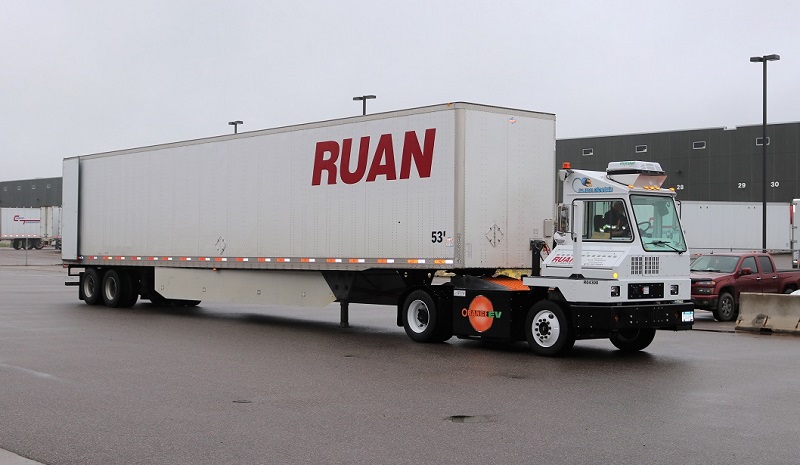Ruan proudly showcased our fully electric yard tractor during the North American Council for Freight Efficiency’s (NACFE) Run on Less – Electric event in September. During the Run on Less, NACFE gathered and published telematics data from 13 fleets and the electric trucks they operate to demonstrate that the transportation industry is ready for heavy-duty vehicle electrification.
“It’s clear from the data collected during the Run that it is time for fleets to go electric in certain market segments, including the van/step van, medium-duty box truck, terminal tractor, and short heavy tractor regional delivery segments,” said Mike Roeth, NACFE’s Executive Director, at the conclusion of the three-week Run on Less. According to NACFE’s initial analysis, if all U.S. and Canadian medium- and heavy-duty trucks became electric, about 100 million metric tons of CO2 would be saved from going into the atmosphere.
As consumers become increasingly concerned about sustainability, so to do the companies that provide goods and services—and it’s a growing expectation that those products be transported in ways that limit the impact on the environment. Carriers are deploying all kinds of sustainable tools and practices, from alternative fuels to auxiliary power units and aerodynamic panels to paperless technologies. Electrification is the next big technology that will allow the industry to reduce its footprint, and nearly all manufacturers are working to bring models of these zero emissions electric trucks to the market.
 During the Run on Less, Ruan’s electric yard tractor, produced by Orange EV, performed well across a variety of metrics. The truck is used 24/7 to move trailers at our dedicated warehouse facility in Otsego, MN.
During the Run on Less, Ruan’s electric yard tractor, produced by Orange EV, performed well across a variety of metrics. The truck is used 24/7 to move trailers at our dedicated warehouse facility in Otsego, MN.
“The results of the Run simply validated what we’ve learned over the last year operating this vehicle—electric trucks require less maintenance, experience more uptime, and provide a smoother and quieter environment for our driving team members, and the battery life has exceeded expectations,” said Vice President of Fleet Services Brad Gehring. “In our yard tractor application, we’re able to charge the unit multiple times throughout the day, so the battery rarely falls below 70 percent state of charge (SOC). After reviewing the Run on Less data from the electric tractors that operate locally in large cities, I’m impressed with their performance and look forward to expanding Ruan’s use of these next-generation vehicles.”
Despite the benefits of the technology, several barriers still exist that limit the widespread adoption of electric vehicles in trucking.
Perhaps most significantly, the upfront cost of electric vehicles is higher than their diesel counterparts. However, as fleets analyze the benefits of electric truck technology over the lifetime of the unit, the initial higher price tag may be overcome by lower maintenance costs and lack of diesel fuel requirements. Also, most states offer grants for fleets to purchase sustainable trucks. Ruan leveraged a Diesel Emissions Reduction Act (DERA) grant to purchase our electric truck in Otsego, and we are pursuing multiple others.
Robust charging infrastructure also needs to be developed for these units, and fleets must engage local utility partners well before in-servicing electric trucks. According to NACFE, it can take up to two years to plan and develop charging capacity and infrastructure.
“As this technology is relatively new, anyone hoping to deploy electric trucks should test them to understand how they operate in real-world situations and then be strategic in how they’re used,” Gehring said. “Right now, they make the most sense for Ruan in yard environments, but we’re looking at their applicability in local and then regional operations. I’m confident our industry will adopt electric trucks, but it will take time and patience.”
Learn more about Ruan’s commitment to helping our partners find the most environmentally-friendly approaches for transporting their goods here.